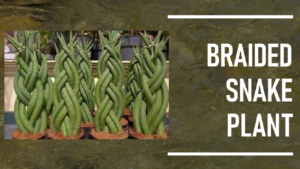The snake plant, also known as Dracaena trifasciata, is one of the most well-known and widespread indoor plants in existence today. These plants are simple to grow but are very sensitive. If the plant is not provided with the appropriate amount of water and sunlight, then it can damage the plant. Overwatering in snake plants has become very common. The leaves will turn yellow and mushy due to overwatering. If the situation is not handled, then gradually the plant will wilt away.
That is why today we will discuss signs of an overwatered snake plant and how you can save it from overwatering!
Signs Of An Overwatered Snake Plant
Overwatering snake plants is not good. Excess water in the plant leads to many issues in the growth and nourishment of the plant. For healthy development, you have to ensure to take proper care of the snake plant. We have listed below some indicators to identify if your snake plant is facing any overwatering issues. Check it out!
1. Leaves dropping in snake plants
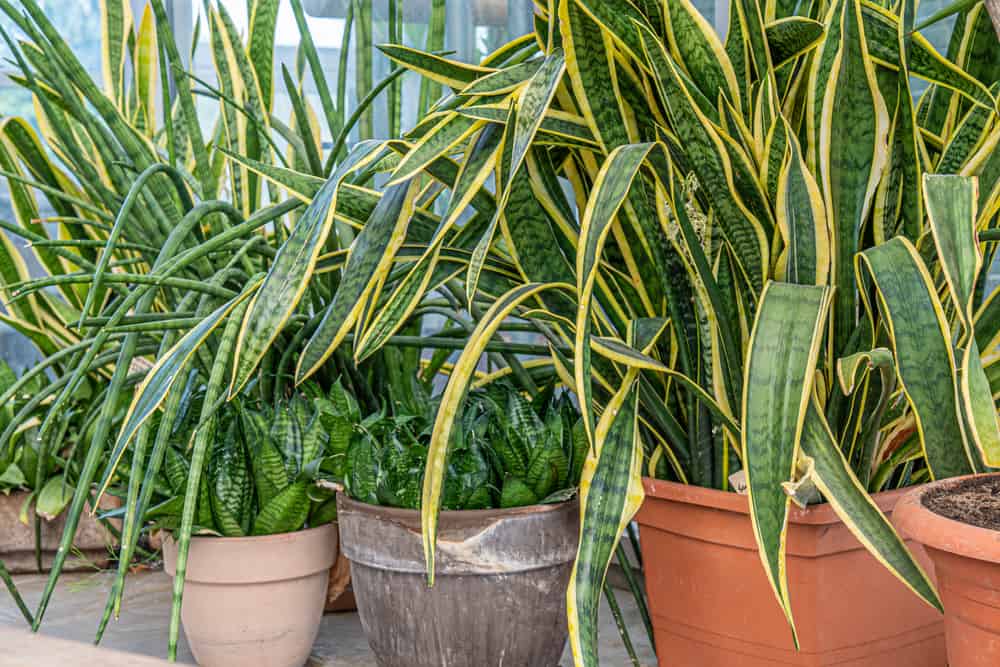
One of the most common signs that you will notice in your overwatered snake plant is the drooping of the leaves. The leaves will begin to get soft and even mushy as they take in too much water and will start to lose their structure, also resulting in them bending over.
The plant won’t exhibit any rot symptoms despite this. Examine the soil in the pot to make sure there isn’t too much moisture present. Because then, it won’t absorb water properly and will be extremely soggy. Ammonia accumulates in the tissues of the plant as a result of the lack of air in the soil. A section of the branch dries out as a result!
You can identify the signs of leaves drooping for two reasons. One, the snake plant’s wet soil indicates that you’ve been overwatering it. And second is that if the soil is dry, you can also consider other elements like temperature, potting soil, stress, or even snake plant drowning for the cause of drooping of leaves.
Maintaining the water level in the plant will ensure a regular flow of minerals in the snake plant avoiding any such situation. Drooping leaves are not healthy for the plant and if not taken care of early, then it may lead the plant to its gradual death. Hence, checking the water flow in the plant is necessary.
2. Brown leaf tips in snake plants
In case of overwatering, this is the second most frequent occurrence in a snake plant. The increased water damage to the leaf may cause the tips to start dying off first. The tips of long snake plant leaves will start to fall off.
Browning of the tips takes time. Due to the damage brought on by overwatering, the tips of the leaves are the first to receive less water, if any at all. Additionally, it will cause the leaf’s tip to turn brown and lose its ability to grow, which will cause it to droop and wither away. By examining the soil’s moisture content, you can determine whether the plant has been overwatered.
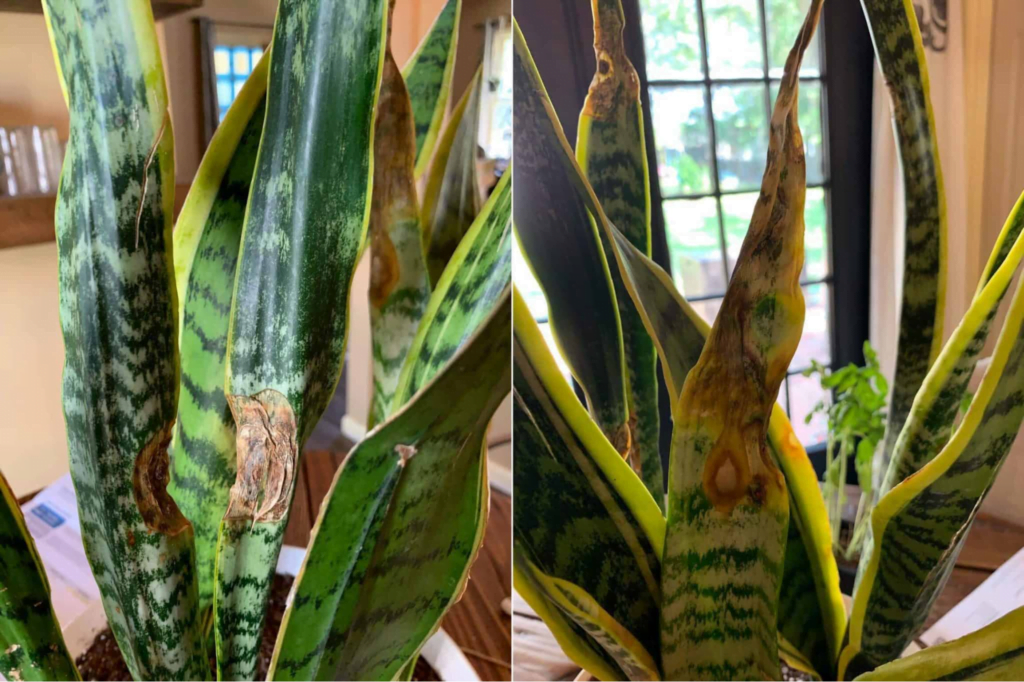
3. Root rots in snake plants
Root rot usually occurs due to the bacterial and fungi outbreak in the snake plant. And one of the most typical and primary contributors to it occurring in a plant is overwatering. Due to excess water present in the soil leaving it damp, it attracts bacteria and fungi towards it that damage the roots in the plant causing the snake plant to wither away slowly.
The roots of a snake plant are white and crusty. Root rot could be affecting your plant if you see patches of the roots turning brown. You can also determine the presence of root rot in a plant by seeing any signs of discoloration in the foliage or the leaves of the snake plant. Moreover, another way to identify root rot in a plant is by smelling the soil the plant is placed in. A stinky soil sample indicates the presence of fungi that grow in wet conditions in the plant.
To prevent root rotting in the snake plant from overwatering, it is advisable to cut out the damaged roots, wash the plant with water thoroughly, and transplant it to a new potting medium. Repotting will greatly help the plant by indicating a better and healthy growth environment around it. Also, controlling the water provided to the plant is essential.
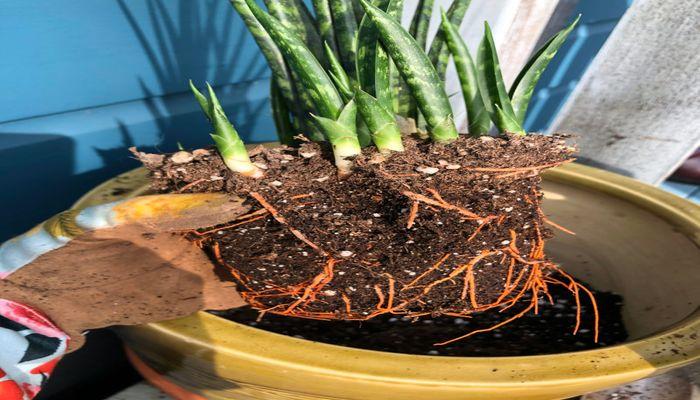
4. Leaves turning yellow in snake plants
Another indication that snake plants are overwatered is yellowing leaves. The nitrogen may be carried away by the additional water as it percolates through the soil, leaving the plant nitrogen-deficient. Because nitrogen is water soluble, it will quickly wash out of the soil.
Further, the nutrient deficiency causes the snake plant to turn its leaves yellow. The inability to absorb any remaining nitrogen in the soil may also be a symptom that the roots are decaying. Yellowing leaves are primarily caused by root rot and excessive watering. It’s because of the decaying that the fungus-infected roots can no longer provide the leaves with the necessary nutrients and water from the soil. Leaving the plant no minerals to grow.
5. Squishy leaves in snake plants
The cell structure of snake plant leaves is severely harmed when they absorb an excessive amount of water. As a result of consuming too much water, leaves eventually rupture and tend to become floppy, mushy, and squishy. It is also one of the most common signs seen in snake plants to identify if the plant is overwatered.
Rigid, green leaves that stand straight up from the plant’s base characterize a healthy snake plant. You can avoid the leaves from turning mushy by limiting the water supply in the plant and taking proper care.
6. Mold in snake plants
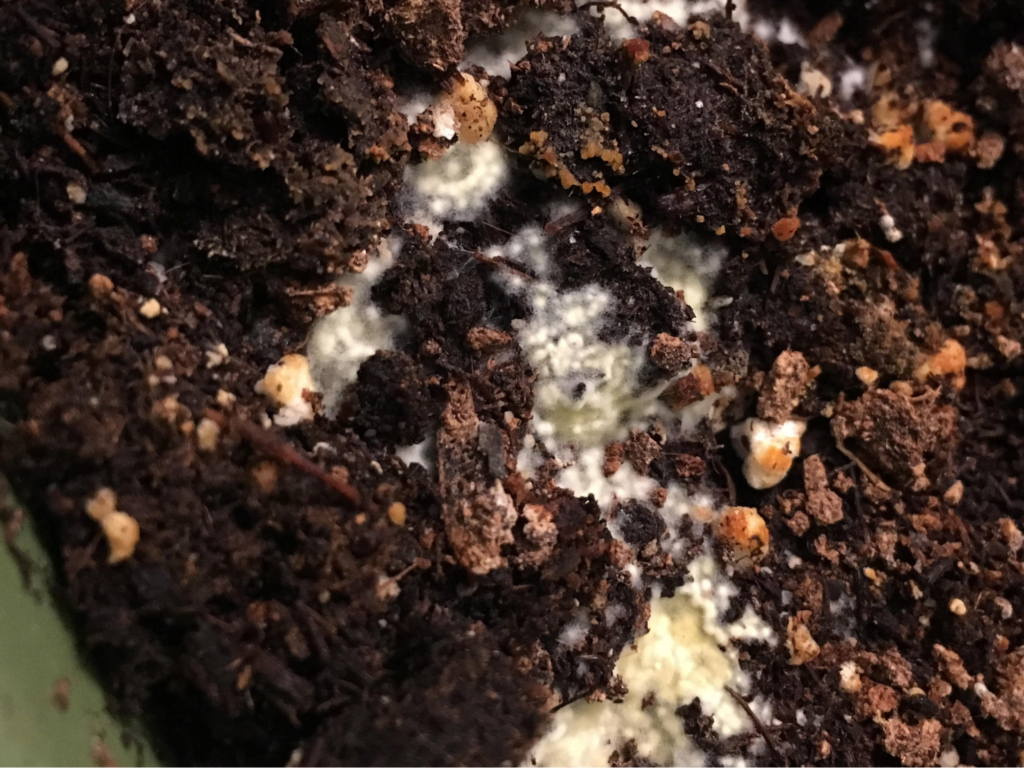
Wet, spongy soil is another indicator that a snake plant is being overwatered. As a result of the soil’s appearance of moisture and prolonged moisture, surface mold may begin to develop. When white or green mold appears on the surface of the soil in pots, the reason is that there is usually too much water in the soil.
Mold on the snake plant can be very harmful to the plant’s development and growth, so if you notice any mold growing on the plant, first ensure to remove it. After that, clean the damaged flowers with a wet paper towel. If mold is still present on the plant after cleaning, it is likely still active, thus it is best to gently remove the damaged components.
As the soil dries out, water the plant and repot it after spraying it with a fungicide. It’s vital to keep a pleasant temperature as quickly as possible because a lack of heat, light, or air can all encourage the spread of mildew.
How To Save An Overwatered Snake Plant?
To save an overwatered snake plant, first, you have to find the problem that has infected the plant. The most common problem is root rot which might have further attracted fungi and bacteria. Since snake plants are hardy so they can recover from overwatering. We have listed below some steps that make it easy to repair a snake plant that has been overwatered.
Step 1: Move the plant to a sunny spot
Placing the snake plant near the window or a sunny pot during their growing period is essential as it increases the drying of the soil. If you are in the primary stage of overwatering, then using the soil drying process will be beneficial and easy. Placing the plant in a sunny spot is also effective to absorb moisture to reduce the messiness of the leaves by overwatering. Hence, changing the snake plant’s place is necessary.

Step 2: Removing the plant
The plant should then be carefully removed from its pot. By lightly stroking the sides of the container, you can successfully remove the plant by loosening the dirt. Carefully remove your snake plant from the pot to uncover the roots after the soil is sufficiently free. Once the plant is out, begin cleaning the soil out of the roots, but be careful not to harm them in any way.
Step 3: Treating Root Rot
Then, examine the roots to find any that show symptoms of the fungus that causes root rot. Plants that are affected have roots that are sticky, foul-smelling, and have brown spots inside of them. Thoroughly check the plant after it’s removed from the container.
You can treat the root rot by the steps that we have mentioned below:
- Rinse the roots of extra dirt. To accurately determine how much harm has been done, it is essential to expose the roots.
- Make sure that only the healthy roots are left in place when you prune all the affected toots. If not all of the affected sources are eliminated, there is a danger that the rot will spread once more.
- After removing the unhealthy roots, you can apply fungicide to the root ball to prevent the fungus from returning in the future.
- Also, before replanting the roots in a clean pot with new potting soil, give the roots a few hours to dry out to avoid any attacks from insects or fungi.
Step 4: Repotting The Plant
Repotting the snake plant into fresh soil is the last step in saving it from overwatering. If the soil is moldy or extremely damp and squishy, you should take this action. It’s also a terrific idea if the plant has turned yellow because the new soil will have an excellent balance of nutrients, including nitrogen.
Remove the plant from the pot, then remove any extra soil. Repot the plant using high-quality, new potting soil that is fresh and well-drained. Before replanting, it is best to wash and sanitize the pot which can aid in removing any mold growth on the container. After the repotting is completed, then wait for a few days for the plant to settle in the soil and then start watering it. Be careful and limit the watering of the snake plant.
Here’s how to repot snake plant step by step,
To re-pot;
- Collect the sanitized tools. Root rake, chopstick, pruner, etc.
- Remove the soil around the root with a root rake.
- Take the plant out and determine if re-potting is needed by inspecting for the level of damaged conditions.
- Even if re-potting is not necessary, clean the soil from the root with a chopstick. The soil can stack up unnecessary minerals from fertilizers so it’s viable to give a fresh set of soil. But be careful while poking with a chopstick, roots of snake plants are fragile and can get damaged easily.
- With a pair of shears, cut the damaged roots. Balance out each root by pruning for a finer upper growth.
- Be it new or the same pot, cover the drainage holes with a mesh.
- Secure the mesh with wire.
- Add a thin layer of draining substance and another layer of soil.
- Place the plant and add more soil to cover any gaps. Play with your fingers around the soil to remove air pockets under it. You can use chopsticks to remove air pockets as well.
- The last would be thoroughly watering the pot, keeping it at room temperature, and humidity.
- Don’t give the plant direct sunlight right away. Wait for a couple of weeks to provide it.
How To Correctly Water The Snake Plant?
Watering snake plants effectively ensures a developed and nourished growth in the plant. You have to keep the method easy and simple. Also, remember to always limit the watering of the plant to avoid any overwatering situation that can cause damage to the plant. Snake plants should be watered at least once a week regularly for better growth.
Water must be poured into a watering can and over the soil until it starts to drip from the drainage hole in the pot. If you keep your plant in a pot on a saucer, make sure it doesn’t sit in water by lifting the pot once or twice a day to drain any additional water. Make sure the soil is totally dry before you water your plants again. The snake plant does not require much water to develop. We have mentioned some suggestions below that you can consider while watering the snake plant!
- Water your snake plant where the roots at. Provide the water at the soil level and continue to apply the water until the plant’s whole root ball is entirely absorbed. Remember that the roots of the snake plants are presumably just as vast as the plant.
- If you want to properly water the plant, I will advise you to invest in a soil moisture meter. Before watering insert the probe of the soil moisture meter a few inches deep in the soil. If the top couple of inches appear dry, then it’s time for watering, if not wait till it feels dry.
- Try to water your plant in the morning instead of the evening. If you overwater the plant, it will get who day to dry out the soil. Snake plants can survive in drought, Their only enemy is excessive water and the diseases caused because of overwatering.
- If the soil surface is dehydrated, water may puddle or run off and not be soaked. The key is to start gradually and slowly build up to a complete soak. Once the top couple of inches are moist, the water will be soaked more smoothly.
- Never water plants with tap water. Depending on where you live, the minerals in your tap water may be particularly high in fluoride or iron, which are not at all healthy for the snake plants. These minerals prevent any water from entering the roots causing them to dry away. So to avoid this situation do not use tap water for any indoor plants.
- Use filtered or purified water for the snake plants. Also, the water should be clean and should not have any trace of unwanted nutrients that is not required by the plant. Ensure a steady floor of water. Overwatering or underwatering can cause harm to the plants as mentioned above. Using a sprayer to water the snake plants will be effective for controlled watering.
- If you decide to move your snake plant, water it slightly more frequently than usual without drowning it. Although you don’t want to hurt your Snake plant, you need to give it some time to establish roots in the fresh pot of soil. When choosing the size of the plant and the pot, take into account how much water you will be feeding it. Water the plant to avoid any damage to it in the future.

FAQ’s
Q1. Should I mist my snake plant?
Ans. No matter how easy it may be, misting your snake plants is not advised. Misting them could result in damage and infections that affect the leaves because they prefer their foliage to be dry. Misting is not always necessary and it is only required by specific plants. Also, ensure to provide your snake plant with all the other amenities it needs
Q2. How do you save a rotting snake plant?
Ans. If your plant displays signs of root rot, take it out of the pot and start over with a fresh soilless mixture. Remove any discolored, mushy roots or leaves before repotting healthy rhizomes in the fresh mixture. If the rhizomes can’t be kept, throw them away. One can start new snake plants by saving a few healthy leaves.
Q3. Do you cut off dead snake plant leaves?
Ans. The leaf tips can occasionally turn dark, especially towards the plant’s edge, and they can even completely drop off at other times. It is simple to remove the dead leaves, but they may indicate that the plant needs to be divided. The leaves can be severed if they have significant damage. Be careful not to cut the snake plant in any way as you work.
Q4. Should I cut brown tips off the snake plant?
Ans. Your snake plant’s brown tips show that it has experienced stress at some point. Cutting off those brown spots won’t harm the plant because they represent dead plant tissue. Simply chop carefully while keeping in mind how you want the plant to look overall. You do not have to remove the complete leaf if only the tip of the plant is damaged.
Q5. What do you do with soggy snake plant leaves?
Ans. If you notice mushy leaves on your Snake Plant, the first thing you should do is check the soil’s moisture level right away and assess the plant’s root structure. If the soil is very wet, take it away from the plant’s roots and replace it fully with new potting soil. Mushy leaves are usually a sign of overwatering in snake plants. The leaves will droop and bend due to the excess water content in the soil. To avoid this situation control the water supply in the plant.
Conclusion
Snake plants are often preferred by plant owners and are also best for beginners to grow. From the information that we have provided above, you might have understood that it is not healthy to overwater your snake plants. It can cause a lot of damage to the plant like root rot, infection of fungi and bacterias, mushy leaves, and gradual death. Excess water is not at all healthy for any plant, so always have a watering schedule for your plant for better growth.
I hope the article was helpful to you and cleared all your doubts regarding the related topic. If you have any further questions, feel free to comment down below, and don’t forget to share this article with your friends and family!


